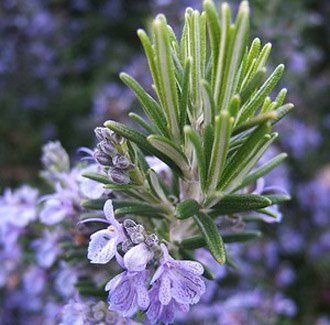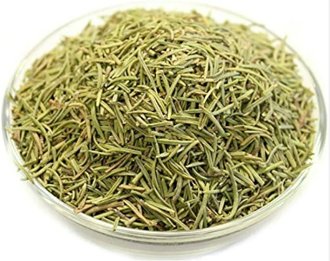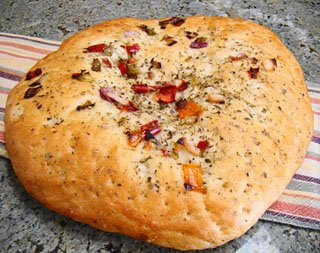Rosemary Herb Nutrition Facts
The charmingly fragrant rosemary herb is a perfect addition to your kitchen garden. It is renowned for its remarkable health benefits, thanks to its abundance of phytonutrients, antioxidants, and essential oils.
Rosemary belongs to the family Lamiaceae, genus Rosmarinus. Botanical name: Rosmarinus officinalis.
Thought to have originated in the Mediterranean region as a wild, strewing evergreen perennial shrub, today it is cultivated in nearly all parts of the Mediterranean area and Asia Minor as a primary culinary herb.
 |
| Rosmarinus officinalis Note needle-like narrow, pointed leaves & lilac rosemary flowers. (Photo-geishaboy500) |
Rosemary flourishes in well-drained, alkaline soil. It prefers sunny conditions but also needs shelter from gusty winds. The plant reaches about 1.5 to 3 meters in height. Its bushy stems and downy young shoots are covered with narrow, needle-like aromatic leaves, about 1 inch long, dark green above and grayish underneath. The plant bears short racemes of small sea-blue flowers appearing in early summer.
The plant parts, including flowers and leaves, have a fragrance that is pungently aromatic and somewhat camphoraceous (camphor-like).
Apart from culinary and medicinal purposes, rosemary shoots, flowers, and leaves are traditionally used in festivals and wedding ceremonies to decorate banquet halls and as incense to ward off bad influences.
Health Benefits of Rosemary Herb
Rosemary leaves contain certain phytochemical compounds derived from plants that are known to possess disease-preventing and health-promoting properties.
The various parts of the herb, particularly the flower tops, contain phenolic antioxidant rosmarinic acid along with several volatile essential oils such as cineol, camphene, borneol, bornyl acetate, α-pinene, etc. These compounds are recognized for their rubefacient (counterirritant), anti-inflammatory, anti-allergic, anti-fungal, and antiseptic properties.
Rosemary leaves offer just 131 calories per 100 g and are devoid of cholesterol. In addition to nutrients, this modest herb contains numerous noteworthy non-nutrient components such as dietary fiber (37% of RDA).
The herb is notably rich in various B-complex vitamins, including folic acid, pantothenic acid, pyridoxine, and riboflavin. It is one of the herbs with high folate levels, providing about 109 µg per 100 g (approximately 27% of RDA). Folates are crucial for DNA synthesis and, when consumed during the peri-conception period, can aid in preventing neural tube defects in newborns.
Rosemary herb contains significant amounts of vitamin A, with 2924 IU per 100 g or approximately 97% of RDA. Introducing a few leaves of this herb into the daily diet would contribute sufficient amounts of this vitamin.
Vitamin A possesses antioxidant properties and is vital for vision. It is also necessary for maintaining healthy mucosa and skin. Consumption of natural foods rich in vitamin A is known to aid the body in protecting against lung and oral cavity cancers.
Fresh rosemary leaves are a rich source of the antioxidant vitamin C, containing about 22 mg per 100 g, which is approximately 37% of RDA. Vitamin C is essential for collagen synthesis in the human body. Collagen is the primary structural protein required for maintaining the integrity of blood vessels, skin, organs, and bones.
Regular consumption of foods rich in vitamin C helps the body protect against scurvy, develop resistance against infectious agents (boosts immunity), and aids in scavenging harmful, pro-inflammatory free radicals from the body.
Rosemary herb parts, whether fresh or dried, are rich sources of minerals such as potassium, calcium, iron, manganese, copper, and magnesium. Potassium is a crucial component of cells and body fluids, aiding in the regulation of heart rate and blood pressure. The human body utilizes manganese as a cofactor for the antioxidant enzyme, superoxide dismutase.
The herb is an excellent source of iron and contains 6.65 mg/100 g of fresh leaves (approximately 83% of RDA). Iron, as a component of hemoglobin within red blood cells, determines the blood's oxygen-carrying capacity.
| Principle | Nutrient Value | Percent of RDA |
|---|---|---|
| Energy | 131 Kcal | 6.5% |
| Carbohydrates | 20.70 g | 16% |
| Protein | 3.31 g | 6% |
| Total Fat | 5.86 g | 20% |
| Cholesterol | 0 mg | 0% |
| Dietary Fiber | 14.10 g | 37% |
| Vitamins | ||
| Folates | 109 µg | 27% |
| Niacin | 0.912 mg | 6% |
| Pantothenic acid | 0.804 mg | 16% |
| Pyridoxine | 0.336 mg | 26% |
| Riboflavin | 0.152 mg | 12% |
| Thiamin | 0.036 mg | 3% |
| Vitamin A | 2924 IU | 97% |
| Vitamin C | 21.8 mg | 36% |
| Electrolytes | ||
| Sodium | 26 mg | 2% |
| Potassium | 668 mg | 14% |
| Minerals | ||
| Calcium | 317 mg | 32% |
| Copper | 0.301 mg | 33% |
| Iron | 6.65 mg | 83% |
| Magnesium | 91 mg | 23% |
| Manganese | 0.960 mg | 42% |
| Zinc | 0.93 mg | 8.5% |

